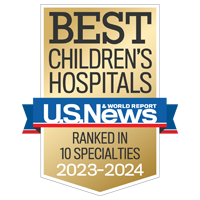Learning never stops
Our classroom and bedside classes help kids get credit and keep learning during treatment.
See our school program

Ewing's sarcoma occurs in the bone or close to the bone, most often in adolescents between the age of 10 and 20. It occurs in about one teenager in 50,000 and accounts for about 30 percent of bone cancers in children. This cancer most often is found in the arms and legs, particularly the thigh bone. It also may involve muscle and soft tissues surrounding the tumor. Ewing's sarcoma cells can spread or metastasize to other areas of the body, including bone marrow and the lungs.
Prior to adolescence, the number of boys and girls affected by Ewing's sarcoma is equal. After adolescence, however, the number of men with the disease is slightly higher than women. This may be due to the increased rate of growth among males during adolescence.
To request an appointment, give us a call.
The following are the most common symptoms of Ewing's sarcoma. Each child, however, may experience symptoms differently.
In addition to a complete medical history and physical examination of your child, diagnostic procedures for Ewing sarcoma will include an X-ray examination of the painful area. There may be multiple diagnostic tests such as:
There are several ways to obtain a sample of the tumor for diagnosis. If the tumor is small and in a good location, the surgeon can completely remove it while your child is under general anesthesia. This is often called an excisional biopsy.
If the tumor is large or cannot be removed without risk to adjacent vital tissue, part of the tumor is removed in an incisional biopsy.
A small sample also can be taken by a needle biopsy, which involves placing a needle through the skin into the tumor. This technique usually isn't used for bone tumors.
If your child is going to have surgery, you may be asked to allow the surgeon to obtain extra tissue for additional studies. No matter what method is used, tissue will be sent to a pathologist, a doctor specializing in diagnosing diseases by laboratory tests.
If your child is going to have general anesthesia for the bone biopsy, the surgeon also may plan other procedures while your child is asleep, to avoid performing more operations than necessary. For example, if your child is thought to have cancer in the chest or elsewhere, the surgeon may want to obtain a biopsy sample of these suspected lumps while your child is still asleep. The pediatric hematologist (blood specialist) and oncologist (cancer specialist) also may perform bone marrow biopsies to determine if the cancer has spread.
At the time of the bone biopsy, a pathologist may examine the tissue under the microscope to determine if it is cancer while your child is still asleep. If it is Ewing's sarcoma, the surgeon can place a central venous access catheter for cancer treatment, an intravenous tube, into the blood vessel of your child's chest during the same operation.
If a biopsy indicates Ewing's sarcoma, additional studies may be performed since Ewing's sarcoma shares some of the same characteristics of other childhood cancers.
Understandably, bone marrow aspirations may be frightening to you and your child. A local quick-acting anesthetic is injected deep under the skin to numb the puncture site and help control pain. Whenever possible, we give you the option of having the procedure performed under general anesthesia. In the aspiration, a sample of the liquid part of bone marrow is removed.
Immediately following a bone marrow aspiration, your child also may undergo a bone marrow biopsy to remove a small core of bone marrow. This procedure may be necessary to confirm the presence of cancer since the liquid may not contain enough cells.
A bone marrow biopsy usually is performed at the same site as the aspirate. Although the biopsy needle may look frightening, only a very small sample of the spongy bone marrow is removed, using a procedure similar to bone marrow aspiration. The difference is that a side-to-side motion of the needle is used to take out a small sample of the spongy marrow, which is the most painful part of the procedure.
A treatment program for Ewing's sarcoma may include several approaches such as surgery, radiation and chemotherapy.
Surgery is used to remove a tumor or remove any tumor left after chemotherapy, which typically lasts about nine weeks. Surgery is performed if complete removal of the tumor is possible without damage to vital tissue or organs.
Chemotherapy uses drugs to kill cancer cells. These drugs may be taken by pill, or injected in a vein or muscle. Chemotherapy is called a systemic treatment because the drug enters the blood stream, travels through the body and can kill cancer cells throughout the body. When more than one drug is used, the treatment is called combination chemotherapy. For treating the Ewing's family of tumors, surgery or radiation often is used to remove the local tumor and chemotherapy is used to kill any cancer cells that remain in the body.
A supplement to the treatment options listed above is myeloablative therapy with stem cell support. This usually is reserved for patients who have resistant disease, recurrence of disease or widely disseminated disease. Myeloablative therapy is a very intense regimen of chemotherapy to destroy all cells that divide rapidly. These cells include some blood cells and hair cells, as well as cancer cells. Stem cells are self-renewing cells that create all of the other various types of blood cells. Stem cell support involves enriching the stem cells to increase the number of these important cells circulating in the blood after the chemotherapy has been given to kill the remaining tumor cells.
Treatment for the Ewing's tumors depends on where the cancer is located, how far the cancer has spread, the stage of the disease, and the age and general health of the patient.
Treatment for localized Ewing's tumors may be one of the following:
Treatment for metastatic Ewing's tumors may be one of the following:
For recurrent tumors, treatment depends on where the cancer has recurred, how the cancer was treated before and the specific medical condition of each child. Chemotherapy may be used for children who did not previously receive chemotherapy. Radiation treatment may be given to reduce symptoms. Surgery may be used to remove tumors that have spread to the lungs or other organs. Clinical trials are testing new treatments.
UCSF Benioff Children's Hospitals medical specialists have reviewed this information. It is for educational purposes only and is not intended to replace the advice of your child's doctor or other health care provider. We encourage you to discuss any questions or concerns you may have with your child's provider.


Best in Northern California for cancer care

Ranked among the nation's best in 10 specialties
Learning never stops
